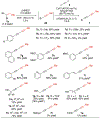Synthesis of 1,3-Diynes via Cadiot-Chodkiewicz Coupling of Volatile, in Situ Generated Bromoalkynes
- PMID: 30336061
- PMCID: PMC6217962
- DOI: 10.1021/acs.orglett.8b02975
Synthesis of 1,3-Diynes via Cadiot-Chodkiewicz Coupling of Volatile, in Situ Generated Bromoalkynes
Abstract
A convenient Cadiot-Chodkiewicz protocol that facilitates the use of low molecular weight alkyne coupling partners is described. The method entails an in situ elimination from a dibromoolefin precursor and immediate subjection to copper-catalyzed conditions, circumventing the hazards of volatile brominated alkynes. The scope of this method is described, and the internal 1,3-diyne products are preliminarily evaluated in ruthenium-catalyzed azide-alkyne cycloadditions.
Conflict of interest statement
The authors declare no competing financial interest.
Figures





Similar articles
-
Recent developments and applications of the Cadiot-Chodkiewicz reaction.Org Biomol Chem. 2015 Jul 7;13(25):6891-905. doi: 10.1039/c5ob00697j. Epub 2015 May 26. Org Biomol Chem. 2015. PMID: 26008847
-
A strictly "pair"-selective synthesis of conjugated diynes via Pd-catalyzed cross coupling of 1,3-diynylzincs: a superior alternative to the Cadiot-Chodkiewicz reaction.Org Lett. 2000 Nov 16;2(23):3687-9. doi: 10.1021/ol000270m. Org Lett. 2000. PMID: 11073676
-
Bulky trialkylsilyl acetylenes in the Cadiot-Chodkiewicz cross-coupling reaction.J Org Chem. 2002 Sep 20;67(19):6841-4. doi: 10.1021/jo025745x. J Org Chem. 2002. PMID: 12227823
-
Recent trends and applications of the Cadiot-Chodkiewicz reaction.Org Biomol Chem. 2019 Oct 23;17(41):9081-9094. doi: 10.1039/c9ob01757g. Org Biomol Chem. 2019. PMID: 31596306 Review.
-
In-situ Generated and Premade 1-Copper(I) Alkynes in Cycloadditions.Chem Rec. 2017 Dec;17(12):1231-1248. doi: 10.1002/tcr.201700011. Epub 2017 Jun 22. Chem Rec. 2017. PMID: 28639363 Review.
Cited by
-
A Simple and Practical Bis-N-Heterocyclic Carbene as an Efficient Ligand in Cu-Catalyzed Glaser Reaction.Molecules. 2023 Jun 29;28(13):5083. doi: 10.3390/molecules28135083. Molecules. 2023. PMID: 37446745 Free PMC article.
-
Cross-coupling reactions towards the synthesis of natural products.Mol Divers. 2022 Feb;26(1):647-689. doi: 10.1007/s11030-021-10195-6. Epub 2021 Feb 20. Mol Divers. 2022. PMID: 33609222 Review.
-
Discovery of a Potent Antiosteoporotic Drug Molecular Scaffold Derived from Angelica sinensis and Its Bioinspired Total Synthesis.ACS Cent Sci. 2024 Feb 21;10(3):628-636. doi: 10.1021/acscentsci.3c01414. eCollection 2024 Mar 27. ACS Cent Sci. 2024. PMID: 38559293 Free PMC article.
References
-
- Siemsen P; Livingston RC; Diederich F Angew. Chem. Int. Ed 2000, 39, 2632. - PubMed
- Shi Shun ALK; Tykwinski RR Angew. Chem. Int. Ed 2006, 45, 1034. - PubMed
- Shi W; Lei A Tetrahedron Lett 2014, 55, 2763.
- Cadiot P; Chodkiewicz W In Chemistry of Acetylenes; Viehe HG, Ed.; Marcel Dekker: New York, 1969; Ch. 9.
-
-
For select examples, see:
Ladika M; Fisk TE; Wu WW; Jons SD J. Am. Chem. Soc 1994, 116, 12093.
Gotteland J-P; Brunel I; Gendre F; Désiré J; Delhon A; Junquéro D; Oms P; Halazy S J. Med. Chem 1995, 38, 3207.
Listunov D; Saffon-Merceron N; Joly E; Fabing I; Génisson Y; Maraval V; Chauvin R Tetrahedron 2016, 72, 6697.
Liang X; Gopalaswamy R; Navas F III; Toone EJ; Zhou P J. Org. Chem 2016, 81, 4393.
Heydenreuter W; Kunold E; Sieber SA Chem. Commun 2015, 51, 15784.
-
-
-
For examples, see:
Carbon-Rich Compounds: From Molecules to Materials; Haley MM, Tykwinski RR, Eds.; Wiley-VCH: Weinheim, 2006.
Egbe DAM; Birckner E; Klemm EJ Polym. Sci., Part A 2002, 40, 2670.
Eisler S; Slepkov AD; Elliott E; Luu T; McDonald R; Hegmann FA; Tykwinski RR J. Am. Chem. Soc 2005, 127, 2666.
-
-
-
For examples, see:
Diederich F Chem. Commun 2001, 219.
Bandyopadhyay A; Varghese B; Sankararama SJ Org. Chem 2006, 71, 454.
Berná J; Goldup SM; Lee A; Leigh DA; Symes MD; Teobaldi G; Zerbetto F Angew. Chem. Int. Ed 2008, 47, 4392.
-
-
-
For reviews related to the hexahydro-Diels-Alder reactions, see:
Holden C; Greaney MF Angew. Chem. Int. Ed 2014, 53, 5746.
Li W; Zhou L; Zhang J Chem. Eur. J 2016, 22, 1558.
Karmakar R; Lee D Chem. Soc. Rev 2016, 45, 4459.
Diamond OJ; Marder TB Org. Chem. Front 2017, 4, 891.
-
Publication types
Grants and funding
LinkOut - more resources
Full Text Sources

